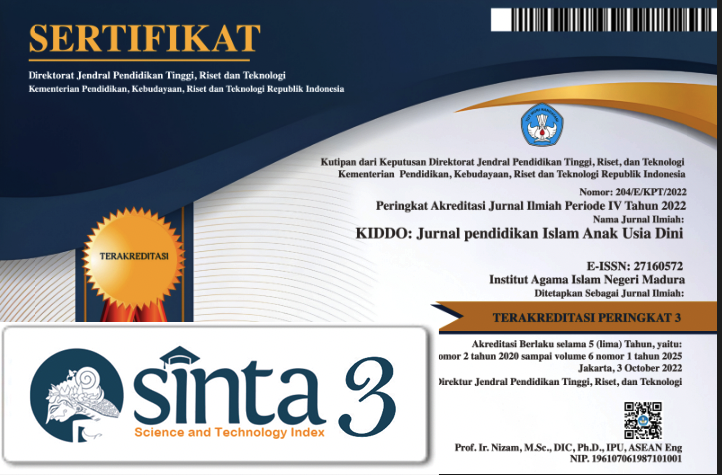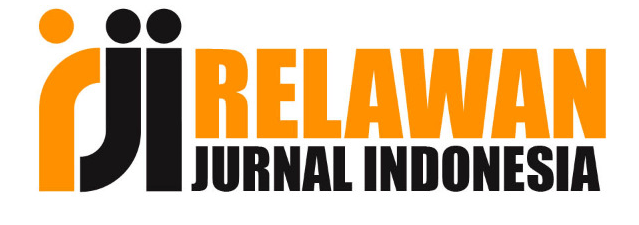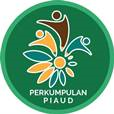Pengembangan Media Boneka Pendidikan Seks Bagi Anak Usia Dini di Kebupaten Jember
 Abstract views: 366
,
Abstract views: 366
,
 PDF downloads: 267
PDF downloads: 267
Abstract
The high frequency of sexual assault charges against young children in the 5–6 year age group served as the impetus for this study. In order to address this issue, early childhood educators must employ engaging and innovative media to teach young children—those between the ages of five and six—about sexuality. Thus, preschool teachers in schools can benefit from the use of sex education puppet media while educating their kids about sex. The purpose of this study is to evaluate the efficacy of using puppetry to introduce young children (ages 5–6) to early sex education. Children between the ages of five and six participated in the research at Kindergarten Amalia Jember. Research and Development (R&D) is the research methodology employed. Techniques for gathering data include observation and questionnaires. Data analysis with product creation and testing the viability of the product. Based on the material expert's evaluation of every facet, the feasibility test has a total score of 21.00, with an average score of 3.00 in the adequate category. The overall score for the aspects evaluated was 41.00, with an average of 2.70 in the sufficient category, depending on how well-suited media experts are. Based on the sample test results, this indicates that the Sig (2-tailed) value is 0.08 > 0.05, it is determined that the development of puppet media for sex education has been effectively established for kids between the ages of 5 and 6.
Downloads
References
Handayani, Alva dan Aam Amiruddin. 2008. Anak Anda Bertanya Seks? :LangkahMudah Menjawab Pertanyaan Anak tentang Seks. Bandung:Khazanah.
Kementerian Pendidikan dan Kebudayaan Republik Indonesia. 2014.
PeraturanMenteri Pendidikan dan Kebudayaan Republik Indonesia Nomor 137 Tahun 2014 tentang Standar Nasional Pendidikan Anak Usia Dini. Jakarta:Kemendikbud.
Nawita, Muslik. 2013. Bunda, Seks itu Apa? : Bagaimana Menjelaskan Seks padaAnak. Bandung: Yrama Widya.
Nugraha, Boyke Dian dan Sonia Wibisono. 2016. Adik Bayi Datang dari Mana? : A-Z
Pendidikan Seks Usia Dini. Jakarta : Noura Books.
Prof.Dr.Sugiyono.2015.Metode PenelitianPendidikan.Bandung:Alfabeta.
Undang-UndangRepublik Indonesia Nomor 20 tahun 2003 tentang Sistem Pendidikan Nasional.
Undang-Undang Republik Indonesia Nomor 35 Tahun 2014 tentang Perubahan Atas
Undang-Undang Nomor 23 Tahun 2002 Tentang Perlindungan Anak.
Joko Widiyanto, 2010. SPSS for Window untuk Analisis Data Statistik dan penelitian.
Surakarta: Badan Penerbit FKIP UMS.
Risa Fitri Ratnasari,M.Alias (2016). Jurnal Tarbawi Khatulistiwa, Vol 02 Halaman 55-58, “Pentingnya Pendidikan Seks Untuk Anak Usia Dini.“
Finkelhor,David (2009). Jurnal The Future of children, Vol 19 Halaman 71-78, “The Prevention of ChildhoodSexual Abuse.”
Sri Wahyuning Astuti (2017). Jurnal Pendidikan Anak, Vol 03 Halaman 236-251,”Pendidikan Seks pada Anak Taman Kanak-kanak Melalui Metode Permainan Ular Tangga.”
Juliete Pepita Felicia, Weny Savitry S. Pandia(2017). Jurnal Pendidikan Anak, Vol 06 Halaman 71-80, “Persepsi Guru TKI Terhadap Pendidikan Seksual Anak Usia Dini Berdasarkan Health-Believe Model”.
Sugiasih,Inhastuti (2017). Jurnal Pendidikan Anak, Vol 06 Halaman 71-81, “Need Assesment Mengenai Pemberian Pendidikan Seksual Yang Dilakukan Ibu untuk Anak Usia 3-5 Tahun”.
Copyright (c) 2024 Tatminingsih Tatminingsih, Hadiqotul Luluk , Barokah Widuroyekti

This work is licensed under a Creative Commons Attribution 4.0 International License.
-
The journal operates an Open Access policy under a Creative Commons 4.0 International license. The terms of the license are:
Share— copy and redistribute the material in any medium or format
Adapt— remix, transform, and build upon the material for any purpose, even commercially.
1. Authors retain copyright and grant the journal right of first publication with the work simultaneously licensed under a Creative Commons License.that allows others to share the work with an acknowledgement of the work’s authorship and initial publication in this journal
2. Authors are permitted and encouraged to post their work online (e.g., in institutional repositories or on their website) prior to and during the submission process, as it can lead to productive exchanges, as well as earlier and greater citation of published work (See The Effect of Open Access).
Jurnal Kiddo is licensed under a Creative Commons
n Access).














